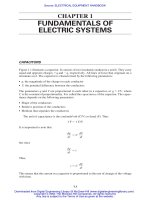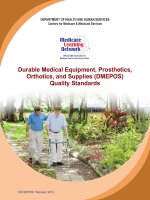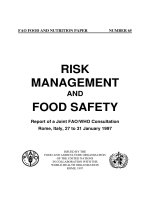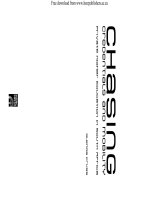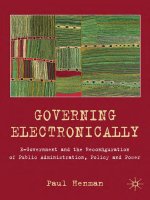Equipment Risk, Training and Maintenance potx
Bạn đang xem bản rút gọn của tài liệu. Xem và tải ngay bản đầy đủ của tài liệu tại đây (86.15 KB, 7 trang )
Department of Chemistry, UOW
Doc: CHEM Equipment Risk Assessment Custodian: Chem. Dept. Doc. Control Page 1 of 7
Created: Oct 2006 Last Review: Next Review: Oct 2007
Equipment Risk, Training and Maintenance
1. Purpose
In a chemical laboratory, a high risk environment may not simply be limited to the use of hazardous
substances. Some instruments either through direct use or in maintenance may place a student or staff
member at some risk. This guideline outlines the identification of hazards and control measures to aid in the
completion of an equipment risk assessment in order to minimise risks that may be associated with
laboratory equipment. It also requires the entry of equipment information into an equipment register.
2. Scope
This guideline and associated documentation should be read by all laboratory supervisors and managers
that have students and staff operating a piece of equipment.
3. References
Risk Management Guidelines
Risk Assessment OHS031.6 />
4. Definitions
Category 1 equipment: A complex piece of equipment or one with medium -high risk that requires formalised
training and assessment of competency before use.
Category 2 equipment: Equipment which has medium complexity or risk, requiring simple training for use.
Category 3 equipment: Equipment that requires little training and is of low risk.
Trainer: The person nominated by the supervisor to carry out training for a particular piece of equipment.
Major equipment facility: In the Department of Chemistry major equipment facilities are considered to be the
NMR facility and Mass Spectrometry Facility.
5. Procedure
5.1. Identify the equipment under your Supervision
Identify the major equipment in your laboratory area and enter the name, manufacturer and model number
in the equipment register (Appendix 1) eg. 300MHz NMR spectrometer, Varian, Mercury Vx.
Include any meaningful identifiers. If possible also include the asset number. Some pieces of equipment
may have more than one asset number. List those you consider most relevant.
5.2. Complete a Risk Assessment
Complete a risk assessment form (document number OHS031.6) for any equipment considered as ‘major’
equipment.
5.2.1. Identification of Hazards
In the operation of equipment or during maintenance procedures identify the substances, processes
and techniques that are used that may represent a hazard. Some examples are:
Equipment Risk, Training and Maintenance
Doc: CHEM Equipment Risk Assessment Custodian : Dept. Chem Doc. Control Page 2 of 7
Created : Oct 2006 Last Review : Next Review: Oct 2007
Hazard Example
High or low temperature
Cryogens, Dry ice, temperatures > 60
0
C
Vacuum traps
High or Low pressures
Gas, Liquid, Mechanical (glass, springs etc)
HPLC
Lasers
Raman Spectrometer
High magnetic fields
NMR – superconducting
magnet
Hazardous Substances
Solvents, Corrosives, Toxic, Mixtures
Biohazardous / Infectious materials
HPLC eluents
Radiation
Ionising and non-ionising
Use of radio-isotopes
Electricity
Is the instrument correctly tagged?
Is the instrument in good working order-
cabling, power plugs.
Power outage – are there contact lists?
Any instrument that has
special power shutdown
procedures.
Mechanical Rotators, auto-injectors
Sharps Use of injection syringes
Manual Handling Operation of equipment
that requires heavy or
awkward lifting.
Ergonomics
Are users in comfortable position in the use
of the instrument?
Repetitive procedures
involved in use of
instrument.
Try also to think laterally about incidents that may occur to identify other possible hazards.
• What could happen if the equipment is not maintained correctly or not used appropriately?
• Are there any special emergency procedures required in the event of power outage?
• Is there procedures that only occur occasionally, perhaps during maintenance?
5.2.2. Controls
The method of ensuring that risks are controlled effectively is by using the “hierarchy of controls”.
The Hierarchy of Controls are:-
Order Control Example
1 Eliminate Removing the hazard, e.g. Taking a hazardous piece of
equipment out of service
2 Substitute Replacing a hazardous substance or process with a less
hazardous one
3 Isolate Isolating the hazard from the person at risk, e.g. using a
guard or barrier. Limit entry to a room.
4 Engineer Redesign an experiment, piece of equipment or process to
make it less hazardous. Ensure e-tagging
5 Administrative Adopt safe work practices. Provide appropriate training,
instruction or information. Use safe work procedures and
ensure training is carried out by a qualified, experience
trainer.
Allow regular breaks for repetitive work or re-organise a work
area. Have a contact list/procedures for power outages.
6 Personal Protective
Equipment
Use of lab-coat, gloves, safety glasses, safety footwear, dust
masks, face shields, goggles etc.
Equipment Risk, Training and Maintenance
Doc: CHEM Equipment Risk Assessment Custodian : Dept. Chem Doc. Control Page 3 of 7
Created : Oct 2006 Last Review : Next Review: Oct 2007
Controls and processes should be monitored and reviewed. Are the controls implemented effective?
Once a year, as part of the workplace inspections, equipment management should be reviewed.
Equipment Risk, Training and Maintenance
Doc: CHEM Equipment Risk Assessment Custodian : Dept. Chem Doc. Control Page 4 of 7
Created : Oct 2006 Last Review : Next Review: Oct 2007
5.2.3. Evaluate the level of risk
Evaluation is based on your knowledge of the hazards involved and the likelihood of something
going wrong. Assess the severity risk to health and environment associated with processes and
materials involved in using the equipment. Complete a risk matrix.
The Risk Matrix is a summary of the hazardous material risks involved in any process. To use the
risk matrix:
1. Consider the consequences
Consequence Personal
Damage
$ Damage Process
Interruption
Environmental
Impact
Major
Extensive Injury
or death
> $100K > 1week Community
alarm
Moderate
Medical
Treatment
$50 - $100K 1day – 1 week Off site impact
Minor
First Aid
Treatment
$5-$50K 1 hour – 1day On site impact
Negligible
No treatment <$5K < 1 hour Potential impact
2. Consider the likelihood
A The event is expected to occur in most
circumstances
B The event could occur at some time
C The event could occur, but only rarely
D The event may occur, but probably never will
3. Take step 1 rating and select the correct column on the
matrix
4. Take step 2 rating and select the correct row on the
matrix
5. The calculated risk score is where the two rating cross
on the matrix
H= High M= Medium L= Low I = insignificant
RISK MATRIX
CONSEQUENCES
Maj Mod
Min
Ins
A
H H H M
B H H M M
C H M M L
LIKELIHOOD
D M M L
L
5.3. Complete a task assessment
• Identify the operational and safety knowledge and skill requirements of your staff and students for
operation of the equipment.
• Determine the complexity of these tasks required for the operation of the equipment, taking into
account the existing knowledge and skills of the new users of the equipment.
Equipment Risk, Training and Maintenance
Doc: CHEM Equipment Risk Assessment Custodian : Dept. Chem Doc. Control Page 5 of 7
Created : Oct 2006 Last Review : Next Review: Oct 2007
5.4. Required Training
Based on the risk and task assessment determine the category of the equipment.
Category 1
This is high risk or
complex equipment
and includes such
instruments as the
NMR, Mass
Spectrometers and
ICP.
• These instruments require specific training to be
carried out by an authorised trainer.
• A display of competency is necessary, meeting set
criteria, before access is granted.
• Training records detailing competency should be
kept.
• A list of current users should also be maintained.
• Those responsible for equipment should also
develop SOP (standard operating procedures) and
SWP (safe work procedures).
Alternatively these may be service instruments where
there is no general access and samples are submitted.
Further assistance in method development can also be
given by the technical manager.
Category 2
This equipment has
medium complexity
or risk such as UV-
Vis
spectrophotometers
, HPLC.
• Basic training on these instruments is provided by a
nominated trainer.
• The trainer may develop a standard operating
procedure -simple instructions of use and carry out
basic training.
• Logbooks are used to monitor who has undertaken
training and usage.
• Further method development is the responsibility of
the supervisor or researcher experienced in the use
of this instrument.
Category 3
These are low risk
simple
instrumentation
such as hotplate
stirrers, rotary
evaporators.
• This category of equipment requires minimal
training to operate and has no formalised training
procedure.
• It may include items such as hotplates, rotary
evaporators.
• Training will generally be carried out by another
experienced user within the laboratory.
• There may or may not be logbooks to monitor use.
5.5. Nominate a person in charge of the equipment
Each piece of equipment identified as category 1 or 2 equipment should have a person nominated to carry
out training. Their name should be entered onto the Equipment register. Complex equipment may also need
a regular maintenance plan and someone nominated to carry out maintenance.
Nominated trainers need to be made aware of their duties such as:-
• Ensuring logbooks are present and completed by users.
• Listing those who are trained or authorised to use the instrument.
• Noting in logbooks the whereabouts of the Manufacturers manuals/ software.
• Being aware of equipment updates (including software).
• Knowing OHS issues associated with the equipment and initiating review of documentation.
Equipment Risk, Training and Maintenance
Doc: CHEM Equipment Risk Assessment Custodian : Dept. Chem Doc. Control Page 6 of 7
Created : Oct 2006 Last Review : Next Review: Oct 2007
Writing and reviewing documentation for the instrument such as safe work procedures or standard operating
procedures should be carried out in collaboration with/ or by a supervisor. Safe work procedures alongside
standard operating procedures constitute an important addition to any equipment training.
For trainers of category 1 equipment completion of a training needs analysis is recommended to help
develop a training and assessment program. Refer to OHS Unit Training Guidelines.
If maintenance support is also required there may also be:-
• A maintenance logbook detailing any maintenance or repairs undertaken.
• The establishment of a routine maintenance plan including function checks. Written procedures for
the equipment outlining maintenance checks, troubleshooting guide.
• Kept supply of spare parts, warranty information and repair contacts.
For postgraduate students/ research assistants nominated as trainers it needs to ascertained for how long
they should have this responsibility and how much will it impact on other duties. There may need to be a
rotation of responsibilities amongst a research group. If staff/students involved in the technical support are
leaving, prior plans need to be made as to who will be the next nominated to support and train.
5.6. Write a safe work procedure
Guidelines for writing safe work procedures can be found at:
/>
Safe work procedures can be useful in training new users and should be easily available or posted by the
instrument. For simple pieces of equipment the SWP should be included, and easily identifiable, in the
Standard Operating Procedures (SOP - instructions for use).
6. Reference Personnel
All changes to this document shall be referred to the Departmental Safety Committee prior to
implementation.
7. Documentation
Equipment register
OHS031.6 Risk Assessment Form
OHS160.1
Safe Work procedure
template
Equipment Risk, Training and Maintenance
Risk Rating Key: I-insignificant, L-low, M-medium, H-high
Department of Chemistry - Equipment Register Entry
Building No. 18/41/41a Room No Laboratory Name:
Academic in Charge: Alternative Contact:
□ No equipment in this Laboratory (tick if applicable)
Asset
Number*
Equipment Name
(include manufacturer)
Model Person in Charge
Training, Maintenance
Risk Rating
(circle)
Risk
Assessment
SWP
I / L / M / H __/__/__ __/__/__
I / L / M / H __/__/__ __/__/__
I / L / M / H __/__/__ __/__/__
I / L / M / H __/__/__ __/__/__
I / L / M / H __/__/__ __/__/__
I / L / M / H __/__/__ __/__/__
I / L / M / H __/__/__ __/__/__
I / L / M / H __/__/__ __/__/__
* If more than one asset number, include what you can.

